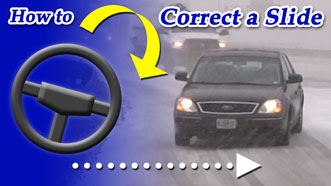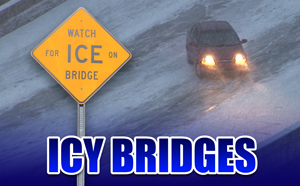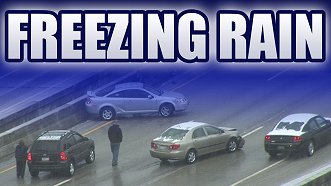Road Icing Danger Zones
During icy road conditions, any road can become dangerous. However, most accidents occur in the following areas:
 Bridges, overpasses and elevated roadways - Elevated roadways collect snow and ice long before the rest of the roads, catching drivers by surprise. This danger zone is so common, we've devoted an entire page to it. Bridges, overpasses and elevated roadways - Elevated roadways collect snow and ice long before the rest of the roads, catching drivers by surprise. This danger zone is so common, we've devoted an entire page to it.
- Steep hills - A more obvious danger zone during road icing is on steep hills. Often, friction forces between tires and the road is not strong enough to overcome gravity to slow or stop a car on an icy hill.
- High speed roadways - Slides and loss of control occur much easier at high speeds. As a result, accidents are common on interstates, freeways and turnpikes.
 Curves - The act of steering can easily cause the rear of a vehicle to slide outward on a curve. Contrary to intuition, cars initially tend to fishtail and slide toward the inside of a curve rather than sliding to the outside. Curves - The act of steering can easily cause the rear of a vehicle to slide outward on a curve. Contrary to intuition, cars initially tend to fishtail and slide toward the inside of a curve rather than sliding to the outside.
- Deceleration spots - Braking is often a major trigger of slides on icy roads. Any part of a roadway that causes a driver to apply the brake is a hotspot for accidents, such as at stop signs, traffic lights, steep hills, construction zones, previous accident sites, sharp curves or highway offramps.
- Acceleration spots - Hitting the gas can cause drive wheels to spin on icy roads, which can easily result in loss of control. Acceleration danger zones include uphill grades on interstates and highway on-ramps.
- Shaded spots - A common danger zone in regions with little to no salting/plowing crews, "shade ice" refers to leftover icy spots that remain in places that receive little sunlight compared to surrounding areas. This can include roads shaded by trees, buildings, bridges/overpasses or any large object. Snow and ice on roads that receive direct sunlight will melt rapidly in warming temperatures, but these shady spots can maintain their ice/snow cover for days after a storm. They are a danger because like bridge icing, they are isolated among long strecthes of roads that are dry, taking drivers by surprise.
- Low-traffic roads - Many times, lesser-traveled roads allow snow and ice to accumulate more easily than in high-traffic areas. Trouble spots to watch for include highway exit ramps, driveways, parking lots and rural roads.
- Tunnels - Tunnels often contain continuous groundwater seepage which can coat roadways with ice during subfreezing conditions, even if no precipitation has fallen. Weather conditions can be different on opposite sides of a mountain, surprising drivers who exit a tunnel and encounter roadways suddenly covered in snow and ice.
- Groundwater & runoff - Particularly in mountainous regions, groundwater and/or runoff from recent rain can flow or drip down onto roadways from nearby cliffs, hills or ditches. When temperatures drop, this water will freeze into a sheet of ice.
 Mountainous regions - Weather conditions can vary greatly with even small changes in elevation. In most cases, air temperatures will fall and rain will change to snow as you climb in elevation. However, a common meteorological condition called an inversion can result in the exact opposite! When traveling in hilly or mountainous regions, be prepared for rapid changes in road conditions. Mountainous regions - Weather conditions can vary greatly with even small changes in elevation. In most cases, air temperatures will fall and rain will change to snow as you climb in elevation. However, a common meteorological condition called an inversion can result in the exact opposite! When traveling in hilly or mountainous regions, be prepared for rapid changes in road conditions.
- Cobblestone and brick pavement - Brick and stone-paved streets are prone to icing up just as fast as bridges and overpasses do, due to the gaps in the road surface that allow cold air to infiltrate downward.
There are many locations that combine two or more of the above hazard zones to create significant danger areas during icy conditions. For instance, a curved, elevated, downhill highway offramp with a traffic light at the end would have a high incidence of crashes during winter precipitation.
Educational Winter Driving Videos - Watch for Free:
  
Home | Risk | Stats | Accident Video | Icy Bridges | Tips | Warning Signs | If You Slide | If You Wreck
1,836
Average annual
deaths in the US
from icy roads
136,309
Average annual
injuries in the US
from icy roads
[ More Statistics ]
|
|

